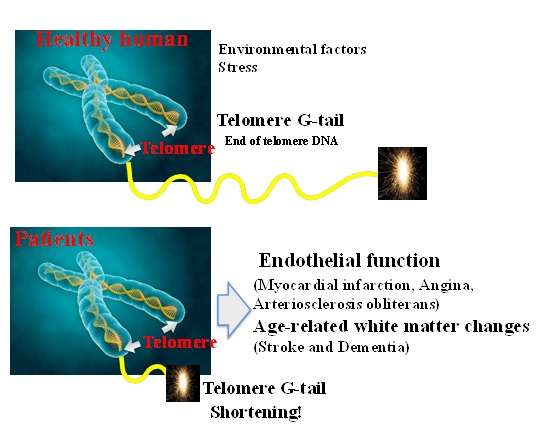A fuse of cardiovascular diseases

A promising biomarker for the severity of age-related white matter changes (ARWMCs) and endothelial function was evaluated at Hiroshima University, Japan. The relationship between this biomarker, the telomeric 3'-overhang (G-tail) length, and cardiovascular risk in humans is unclear so far. The researchers at Hiroshima University investigated the association between the telomere G-tail length of leukocytes and vascular risk, ARWMCs, and endothelial function. They suggested that the telomere G-tail might be a useful marker of endothelial dysfunction, as well as stroke and dementia.
Telomeres are the structures that cap each end of a chromatid, at the extreme end of the chromosomal DNA. Telomeres are composed of double-stranded DNA with terminal 3' single-stranded G-rich overhangs called telomere G-tails. The telomere G-tail length is essential for the biological effects of telomere dysfunction in vitro. However, the association of the telomere G-tail length with various risk factors in humans has not been clarified yet.
In patients with chronic cerebrovascular disease and comorbidities, a shortened telomere G-tail length was associated with age and Framingham risk score, which is an algorithm used to estimate the 10-year cardiovascular risk of an individual. In addition, telomere G-tail length was positively correlated with flow-mediated dilation (FMD) values and negatively correlated with the severity of ARWMCs. In the multivariate regression analysis, telomere G-tail length was independently associated with FMD values and severity of ARWMCs, whereas the total telomere length was not associated with these indicators. The study protocol was governed by the guidelines of the Japanese government, based on the Helsinki Declaration. The study was approved by the Institutional Research and Ethics Committee of Hiroshima University Hospital.
"We and MiRTeL Co. Ltd. previously developed a high-sensitivity and high-throughput method of telomere G-tail measurement. By using this technique, we demonstrated that the telomere G-tail length of leukocytes is significantly correlated with endothelial function and severity of ARWMCs," said Professor Hidetoshi Tahara, a principal investigator of this study at the Department of Cellular and Molecular Biology, Hiroshima University.
The research group, including Professor Masayasu Matsumoto and Dr. Tomohisa Nezu, at the Department of Clinical Neuroscience and Therapeutics, Hiroshima University, mentioned that this study has several limitations. Nevertheless, it provides initial evidence for the association of telomere G-tail length with aging, endothelial function, and ARWMCs in patients with vascular risk factors.
More information: Nezu, Tomohisa, Hosomi, Naohisa, Takahashi, Tetsuya, Anno, Kumiko, Aoki, Shiro, Shimamoto, Akira, Maruyama, Hirofumi, Hayashi, Tomonori, Matsumoto, Masayasu, Tahara, Hidetoshi, "Telomere G-tail length is a promising biomarker related to white matter lesions and endothelial dysfunction in patients with cardiovascular risk: a cross-sectional study", EBioMedicine (2015) DOI: 10.1016/j.ebiom.2015.05.025



















